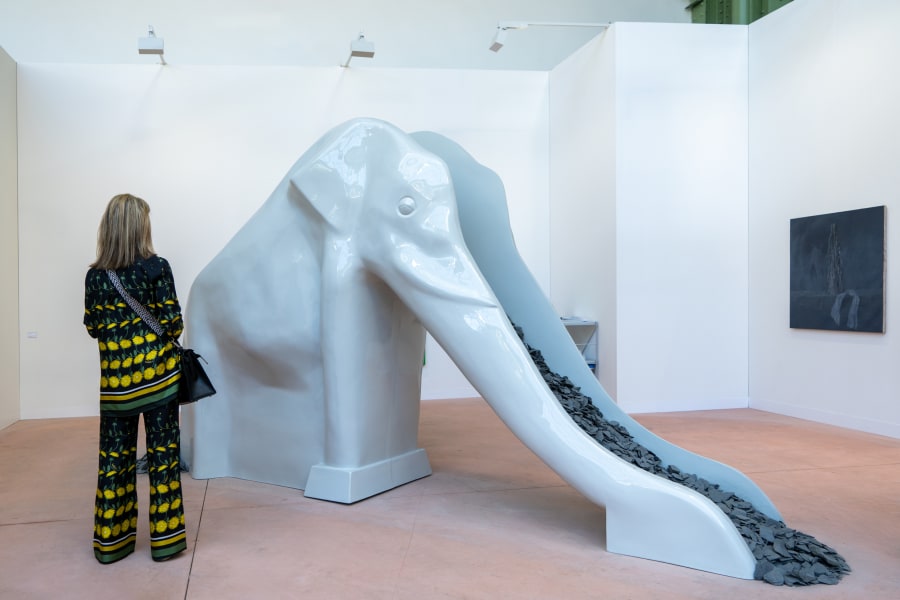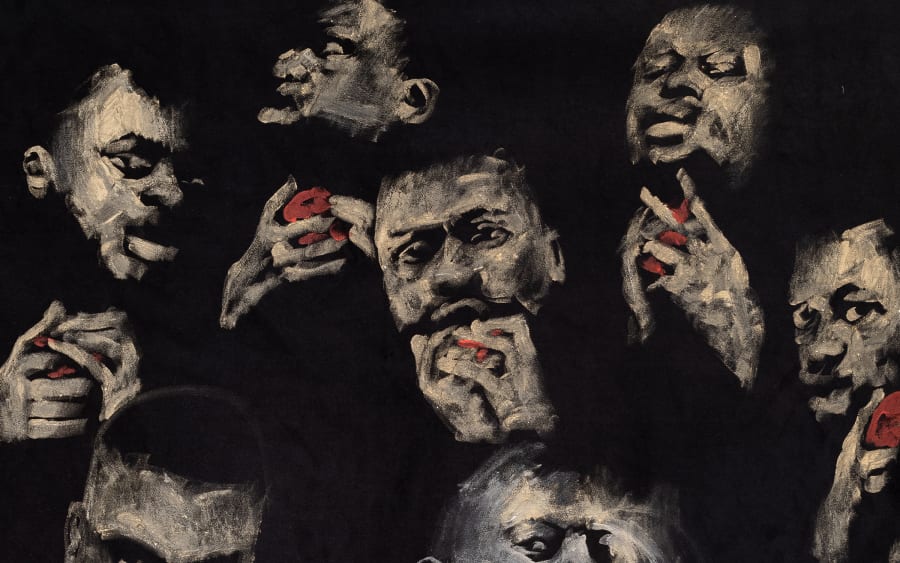Forty-eight hours before an Art Basel fair opens, chaos appears to reign on the show floor. Tall forklifts reverse through narrow aisles; massive crates are wheeled around and pried open; installers paint walls, apply veneers, and gently cradle bronze sculptures in pillowy transportation blankets as if they were gargantuan babies. But don’t be fooled: Behind this apparent disorder is a finely tuned system – one where specialized knowledge prevails, communication is essential, and creative improvisation can solve critical issues in minutes. In many ways, the buildup of an art fair mirrors the art market itself.
So what exactly is the art market? Who are its key players, how is it structured, and what makes it distinct from other markets?
At its core, the art market is a global network of individuals, businesses, and institutions involved in the creation, promotion, sale, and resale of artworks. Artists, of course, are at the center. They conceive and produce artworks – the actual goods that are being sold. The diversity of artistic expression, even within the scope of Modern and contemporary art, is staggering. From Gertrude Abercrombie’s miniature surrealist paintings to John Akomfrah’s cinematic video installations, or Sasha Stiles’s NFTs, artistic formats and voices are as diverse as the crystalline structures of snowflakes. But the concept is always key. ‘The art market is one where you sell and buy ideas, whether they end up being a physical object or not,’ says Vincenzo de Bellis, Director of Fairs and Exhibition Platforms for Art Basel.
While some artists manage their sales independently, many are represented by commercial galleries; this is known in industry parlance as being on a gallery’s ‘roster’. These galleries vary widely in scale and mission. Some, like Hauser & Wirth, Pace, and David Zwirner, operate globally with multiple locations and extensive programming. This segment is often referred to as ‘blue-chip’ – a term that originates from poker, where blue chips carry the highest value; in the art world, it refers to galleries and artists considered the most highly valued, established, and reliable investments. Other galleries work on a much smaller scale, championing young and emerging artists – like Montreal’s Bradley Ertaskiran, Tokyo’s Kayokoyuki, or Mexico City’s Llano. There are also galleries with a thematic or geographic focus: South Africa’s Goodman Gallery, for instance, highlights artistic positions from the Global South and its diasporas, while London’s Annely Juda Fine Art has become synonymous with a particular historical movement – in this case, early 20th-century Russian Constructivism.
Galleries frequently come together at art fairs, where they showcase their programs alongside peers. These events are pivotal to their business: In 2024, fairs accounted for 31% of dealer sales, up 2% from the previous year, according to The Art Basel and UBS Art Market Report 2025. Some fairs spotlight regional ecosystems, while others – like Art Basel and Frieze – bring together leading galleries from around the globe. At these events, galleries connect with collectors, institutional buyers, and other market players.
For those who follow fairs closely, it can be fascinating to track the evolution of a gallery or artist. They might debut in a section dedicated to emerging voices, with smaller, more affordable booths, before advancing to the main sectors of major fairs. London’s Carlos/Ishikawa had its first outing at Art Basel in Basel in 2017 in the Statements sector, the platform for solo presentations by emerging artists (it had also participated in Hong Kong’s main Galleries sector the year prior). The gallery has helped launch the careers of market darlings such as Issy Wood and Oscar Murillo and over time, it has progressed to the main sectors of Art Basel’s Basel and Paris editions and continued to show in Hong Kong, while its co-founder, Vanessa Carlos, was appointed to the latter’s prestigious selection committee – a body that reviews applications and determines exhibitors.
Auction houses are equally important players but operate differently. Say your grandmother left you a painting by monochrome master Pierre Soulages, a memento from her bohemian days in 1950s Paris. If you chose to sell it through an auction house, their specialists would evaluate the piece, set a price range – known as the estimate – and most often include it in an upcoming public auction. The painting would then be sold to the highest bidder, providing that the bid meets or exceeds the reserve price. If it doesn’t, the work remains unsold for the time being. For those wanting a more discreet approach, auction houses also conduct private sales, shielding sellers (and their artworks) from the public eye.
While Sotheby’s, Christie’s, Phillips, and Bonhams dominate the field globally, numerous smaller houses also play a critical role – especially regionally. Vienna’s Dorotheum and Drouot in Paris are notable examples with a local influence that can rival the international giants. It should be stated that it’s equally possible to entrust your Soulages to a gallery, who will also be able to find a buyer. Private dealers, who may not have permanent gallery spaces, are other important figures in the art market. Increasingly, artists’ agents, who represent an individual’s interest and focus on more than just sales, are also entering the field, sometimes blurring traditional boundaries. De Bellis highlights Vienna-based dealer Amir Shariat as an example – he discovered Ghanaian artist Amoako Boafo in the Austrian capital in 2019 and has been instrumental in the painter’s rapid ascent to international acclaim.
Auction houses and many private dealers operate primarily within the secondary market, which refers to works that have been previously owned (your grandmother’s Soulages, for example). Many galleries also specialize in this area, especially those dealing with historical pieces – which can range from antiquities to Postwar American art. New York’s Di Donna is a good example. Conversely, the primary market involves artworks sold for the first time, often directly consigned by the artist. Some galleries also blend both market segments to diversify their offerings. Mennour, in Paris, mainly represents contemporary artists such as Alicja Kwade and Bertrand Lavier, but also regularly presents secondary-market works by 20th-century masters such as Alberto Giacometti and Jean Dubuffet at fairs.
Pricing across both markets depends on supply and demand but is also shaped by additional factors. When a gallery begins representing a little-known artist, it typically sets prices conservatively (but not massively below those of similar artists in its program) in order to assess interest. Price growth in the primary market is usually gradual and influenced by numerous variables: Is there collector demand, particularly from those with prestigious collections? Is the artist featured in significant institutional shows, locally and internationally? Are museums acquiring their work? What are the production costs, and how prolific is the artist?
These factors help structure a controlled price evolution – in stark contrast with the often-volatile secondary market. At auctions, where the secondary market overwhelmingly unfolds, artworks by in-demand artists may skyrocket to ten times their estimate, only to crash the following year. Crucially, artists or their estates rarely benefit financially from such price spikes, since they’re not the sellers. A notable exception is Damien Hirst, who famously bypassed his galleries in 2008 to sell new works directly through Sotheby’s – a highly unconventional move at the time.
But what motivates someone to buy art? Passion is usually a big reason. Art collecting can shape lives and build legacies. American collectors Eli and Edythe Broad, for example, began acquiring works in the 1970s after launching a successful prefab home business. That first acquisition – a Van Gogh – led to a great many more, culminating in the opening of The Broad museum in Downtown Los Angeles in 2015. And while most collectors don’t build their own museums, their commitment can be just as deep. A new generation is also reshaping collecting habits, particularly through digital channels. According to The Art Market Report 2025, millennial and Gen Z collectors bought 22% of their art online in 2024, and online sales represented 18% of total sales that year – up 5% since 2019. Furthermore, new art forms have been reshuffling things as well: NFTs, for example, often bypass traditional intermediaries altogether and require no physical storage. They can be acquired on platforms like SuperRare or Nifty Gateway, expanding access and challenging established norms.
An unquantifiable yet defining trait of the art market is the central role of personal relationships. Buying or selling art is rarely a cold business transaction – it’s often emotional and rooted in trust. A painting or sculpture typically has no practical use; as such, market interactions can feel more like exchanges between confidants than between a buyer and vendor. Deep bonds form, whether between an artist and their dealer, a collector and a gallery director, or a museum curator and a specialist at an auction house. These strong relationships are also key to unlocking complex discussions, from logistical constraints to price negotiations. And once such concerns are dealt with, art is ready to be marveled at, engaged with, and celebrated – just like at the opening of an Art Basel fair, once the busy build-up is complete.
Karim Crippa is Senior Editor at Art Basel and Head of Communications for Art Basel Paris.
Top image: Art Basel Paris 2024 at the Grand Palais.


